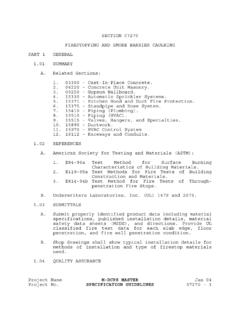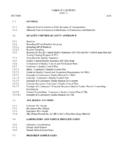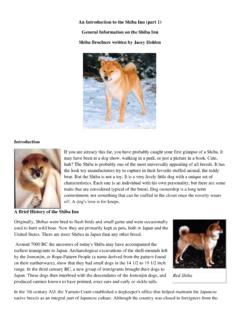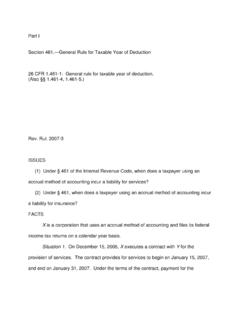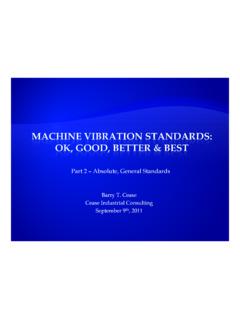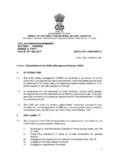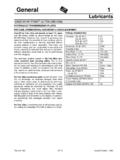Transcription of DEPARTMENT OF LICENSING AND REGULATORY …
1 1 MIOSHA-STD-1158 (03/16) 10 Pages For further information Ph: 517-284-7740 DEPARTMENT OF LICENSING AND REGULATORY AFFAIRS DIRECTOR S OFFICE GENERAL INDUSTRY SAFETY STANDARDS Filed with the Secretary of State on May 10, 1993 (as amended March 4, 2016) These rules become effective immediately upon filing with the Secretary of State unless adopted under section 33, 44, or 45a(6) of 1969 PA 306. Rules adopted under these sections become effective 7 days after filing with the Secretary of State. (By authority conferred on the director of the DEPARTMENT of LICENSING and REGULATORY affairs by sections 16 and 21 of 1974 PA 154, MCL and , and Executive Reorganization Order Nos.)
2 1996-2, 2003-1, 2008-4, and 2011-4, MCL , , , and ) R and R of the Michigan Administrative Code are amended as follows: PART 85. THE CONTROL OF HAZARDOUS ENERGY SOURCES Table of Contents: R Scope.. 1 R Adoption by reference of federal standard.. 1 R Availability of adopted rules.. 1 CONTROL OF HAZARDOUS ENERGY (LOCKOUT/TAGOUT) .. 2 (a) Scope, application, and purpose .. 2 (b) Definitions applicable to this section.. 3 (c) 4 (d) Application of control.. 6 (e) Release from lockout or tagout.. 7 (f) Additional requirements.
3 8 Appendix A - Typical minimal lockout procedures .. 9 R Scope. Rule 8501. (1) These rules establish minimum requirements for the lockout/tagout of energy sources for the protection of employees, in, on, or around machines, equipment, or a process during repair, maintenance, and associated activities, from injury due to unexpected/unintended motion, energization, start-up, or release of stored energy from the machine, equipment, or process. (2) Except where the provisions of these rules conflict with specific requirements for the lockout/tagout of energy sources in any other general industry safety standard, the provisions of these rules and the requirements specified in any other general industry safety standard rule shall be deemed to have concurrent application.
4 Where a specific general industry safety standard contains lockout/tagout requirements, the specific provisions set forth in the general industry safety standard shall prevail if there is a conflict with the requirements set forth in these rules. R Adoption by reference of federal standard. Rule 8502. (1) The following federal occupational safety and health administration (OSHA) regulations are adopted by reference in these rules: (a) 29 The control of hazardous energy (lockout/tagout), as amended May 2, 2011.
5 (b) 29 Appendix A Typical minimal lockout procedures, as amended February 13, 1996. (2) The adopted federal regulations shall have the same force and effect as a rule promulgated under 1974 PA 154, MCL to R Availability of adopted rules. Rule 8599. (1) The standards adopted in these rules are available from the United States DEPARTMENT of Labor, Occupational Safety and Health Administration website: at no charge, as of the time of adoption of these rules. 2 (2) The standards adopted in these rules are available for inspection at the DEPARTMENT of LICENSING and REGULATORY Affairs, MIOSHA REGULATORY Services Section, 530 West Allegan Street, Box 30643, Lansing, Michigan, 48909-8143.
6 (3) The standards adopted in these rules may be obtained from the publisher or may be obtained from the DEPARTMENT of LICENSING and REGULATORY Affairs, MIOSHA REGULATORY Services Section, 530 West Allegan Street, Box 30643, Lansing, Michigan, 48909-8143, at the cost charged in this rule, plus $ for shipping and handling. CONTROL OF HAZARDOUS ENERGY (LOCKOUT/TAGOUT) Table of Contents: (a) Scope, application, and purpose .. 2 (a)(1) Scope .. 2 (a)(2) Application.. 3 (a)(3) Purpose.
7 3 (b) Definitions applicable to this 3 (c) General .. 4 (c)(1) Energy control program.. 4 (c)(2) Lockout/tagout.. 4 (c)(3) Full employee protection.. 4 (c)(4) Energy control procedure.. 4 (c)(5) Protective materials and hardware. 5 (c)(6) Periodic inspection.. 5 (c)(7) Training and communication.. 6 (c)(8) Energy isolation.. 6 (c)(9) Notification of employees.. 6 (d) Application of control.. 6 (d)(1) Preparation for shutdown.. 7 (d)(2) Machine or equipment shutdown.. 7 (d)(3) Machine or equipment isolation.
8 7 (d)(4) Lockout or tagout device (d)(5) Stored energy.. 7 (d)(6) Verification of isolation.. 7 (e) Release from lockout or tagout.. 7 (e)(1) The machine or equipment.. 7 (e)(2) Employees.. 7 (e)(3) Lockout or tagout devices removal. 7 (f) Additional requirements.. 8 (f)(1) Testing or positioning of machines, equipment or components thereof.. 8 (f)(2) Outside personnel (contractors, etc.).8 (f)(3) Group lockout or 8 (f)(4) Shift or personnel changes.. 8 Appendix A Typical minimal lockout procedures .. 9 9 Lockout Procedure.
9 9 Purpose .. 9 Compliance With This Program .. 9 Type of compliance enforcement to be taken for violation of the above.. 9 Sequence of Lockout .. 9 Name(s)/Job Title(s) of affected employees and how to notify.. 9 Type(s) and magnitude(s) of energy, its hazards and the methods to control the energy.. 9 Type(s) and location(s) of machine or equipment operating controls.. 9 Type(s) and location(s) of energy isolating devices.. 9 Type(s) of stored energy - methods to dissipate or restrain.. 10 Method of verifying the isolation of the 10 Restoring Equipment to Service.
10 10 (a) Scope, application, and purpose (a)(1) Scope (a)(1)(i) This standard covers the servicing and maintenance of machines and equipment in which the unexpected energization or start up of the machines or equipment, or release of stored energy, could harm employees. This standard establishes minimum performance requirements for the control of such hazardous energy. (a)(1)(ii) This standard does not cover the following: (a)(1)(ii)(A) Construction and agriculture employment; (a)(1)(ii)(B) Employment covered by parts 1915, 1917, and 1918 of this title; (a)(1)(ii)(C) Installations under the exclusive control of electric utilities for the purpose of power generation, transmission and distribution, including related equipment for communication or metering.










